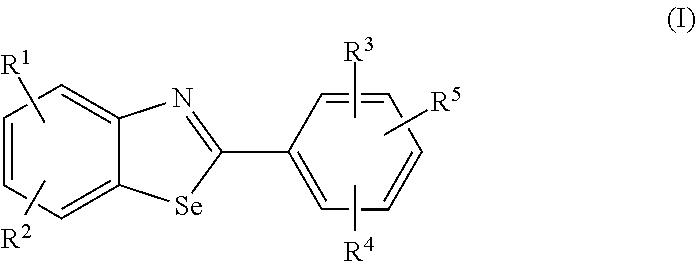Compounds for the treatment or prevention of breast cancer
a technology of compound and breast cancer, applied in the field of pharmaceutical chemistry, can solve the problems of breast cancer becoming the second most common malignant tumor in the world, threatening the health of chinese females, and increasing morbidity and mortality so as to improve the physicochemical properties, inhibit the growth or proliferation of breast cancer cells, and achieve remarkable pharmaceutical effects
- Summary
- Abstract
- Description
- Claims
- Application Information
AI Technical Summary
Benefits of technology
Problems solved by technology
Method used
Image
Examples
embodiment 1
Synthesis of 4-(benzoselenazole-2-yl)-2-bromoaniline (7)
[0075]
[0076]Step A: A solution of 2-nitroaniline(15.0 g, 108 mmol) in dichloromethane (150 mL) was added dropwise into boron trifluoride diethyl etherate (23.1 g, 163 mmol) at −10□ to −15□ and stirred for 15 min, and a solution of isoamyl nitrite (15.26 g, 130 mmol) in dichloromethane (75 mL) was added dropwise at this temperature. At the end of addition, the reaction mixture was continuously stirred for 30 minutes, and then stirred for 30 minutes at −10□ to 0□. The reaction system was added with cold petroleum ether (250 mL) dropwise and then filtered. The filter cake was washed with cold methyl tert-butyl ether (MTBE) (40 mL) to obtain 2-nitro-phenyl-diazonium tetrafluoroborate (1) (18.7 g). The yield was 73.1%.
[0077]Step B: A solution of potassium selenocyanate (8.0 g, 55.5 mmol) in water (80 mL) was added into a mixture of the compound 1 (13.0 g, 54. 9 mmol) and water (300 mL) in an ice-water bath, and the reaction mixture ...
embodiment 2
Synthesis of 4-(5-fluorobenzoselenazole-2-yl)aniline (13) and 2-bromo-4-(5-fluorobenzoselenazole-2-yl)aniline (14)
[0083]
[0084]Step A: A solution of 2-nitro-4-fluoroaniline (5.0 g, 32.0 mmol) in dichloromethane (50 mL) was added dropwise into boron trifluoride diethyl etherate (6.8 g, 47.9 mmol) at −10□ to −15□ and stirred for 15 min, and a solution of isoamyl nitrite (4.5 g, 38.4 mmol) in dichloromethane (25 mL) was added dropwise at this temperature. At the end of addition, the mixture was continuously stirred for 30 minutes, and then stirred for 30 minutes at −10□ to 0□. The reaction mixture was added with cooled petroleum ether (80 mL) dropwise and then filtered. The filter cake was washed with cold MTBE (10 mL) to obtain 2-nitro-4-fluorophenyl-diazonium tetrafluoroborate (8) (13.0 g). The compound was directly used in the next reaction without purification.
[0085]Step B: A solution of potassium selenocyanate (4.84 g, 33.6 mmol) in water (30 mL) was added into a mixture of the cru...
embodiment 3
Synthesis of 4-(5-fluorobenzoselenazole-2-yl)-2-methylaniline (17)
[0091]
[0092]Step A: Zinc powder (5.5 g, 84.1 mmol) was added into a suspension of the compound 10 (2.0 g, 4.57 mmol) in acetic acid (40 mL) at 40□, then heated to 100□ and continuously stirred for 3 h. The reaction mixture was cooled below 50□, slowly added with 6M hydrochloric acid (40 mL) and filtered to remove insoluble substances. The filtrate was adjusted with 20% sodium acetate until the pH value was 2 to 3, and the solid was collected by filtration and dried to obtain di[(2-amino-4-fluorophenyl)seleno]zinc (15) (1.2 g). The yield was 61.9%.
[0093]Step B: A mixture of the compound 15 (590 mg, 3.10 mmol) and 3-methyl-4-nitrobenzoyl chloride (663 mg, 3.32 mmol) was stirred for 4 h at 100□. The mixture was cooled to the room temperature, added with saturated sodium bicarbonate aqueous solution (15 mL) and extracted with ethyl acetate (30 mL×2). The combined organic phase was washed with saturated saline solution (10...
PUM
| Property | Measurement | Unit |
|---|---|---|
| density | aaaaa | aaaaa |
| hydrolysable | aaaaa | aaaaa |
| resistance | aaaaa | aaaaa |
Abstract
Description
Claims
Application Information
 Login to View More
Login to View More - R&D Engineer
- R&D Manager
- IP Professional
- Industry Leading Data Capabilities
- Powerful AI technology
- Patent DNA Extraction
Browse by: Latest US Patents, China's latest patents, Technical Efficacy Thesaurus, Application Domain, Technology Topic, Popular Technical Reports.
© 2024 PatSnap. All rights reserved.Legal|Privacy policy|Modern Slavery Act Transparency Statement|Sitemap|About US| Contact US: help@patsnap.com










